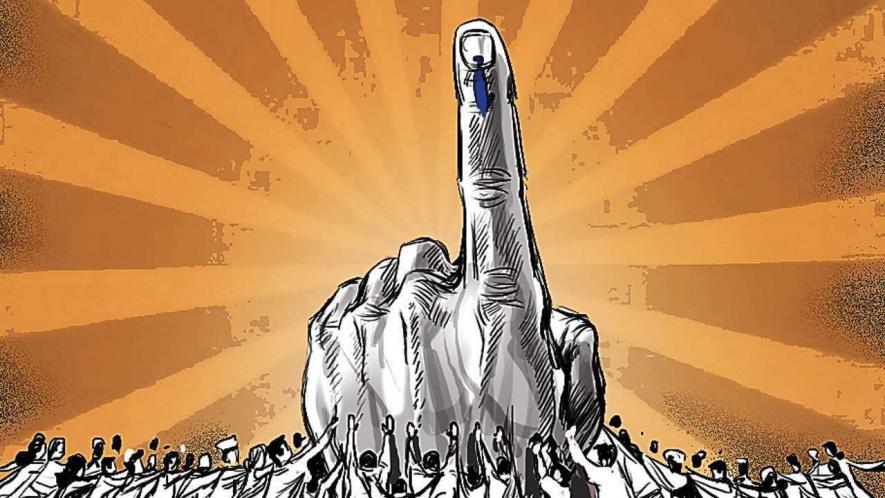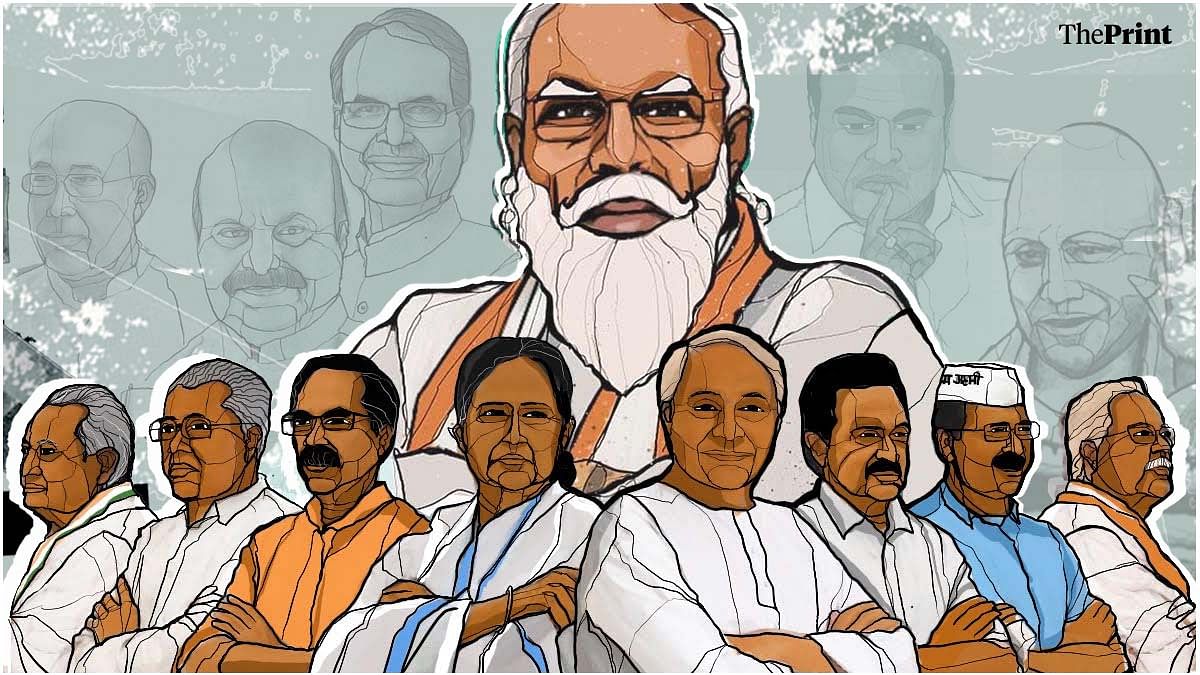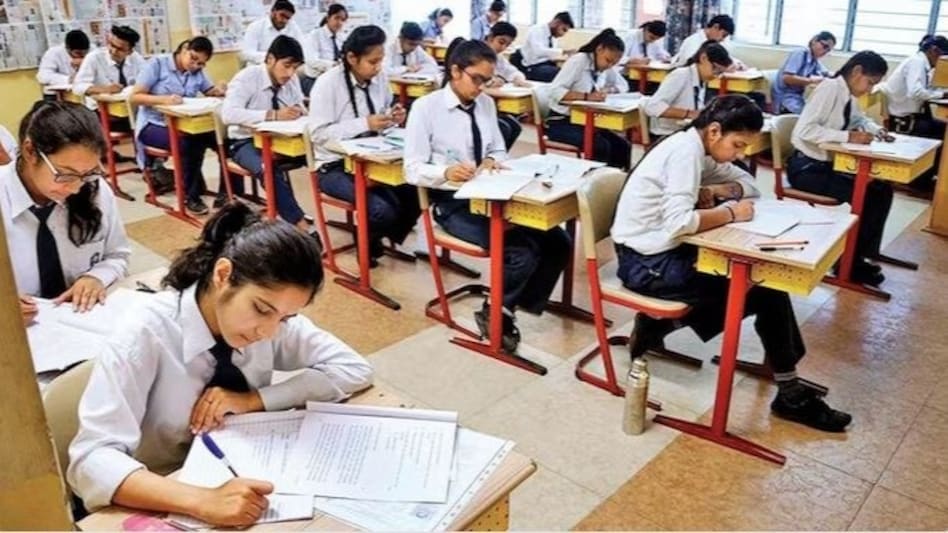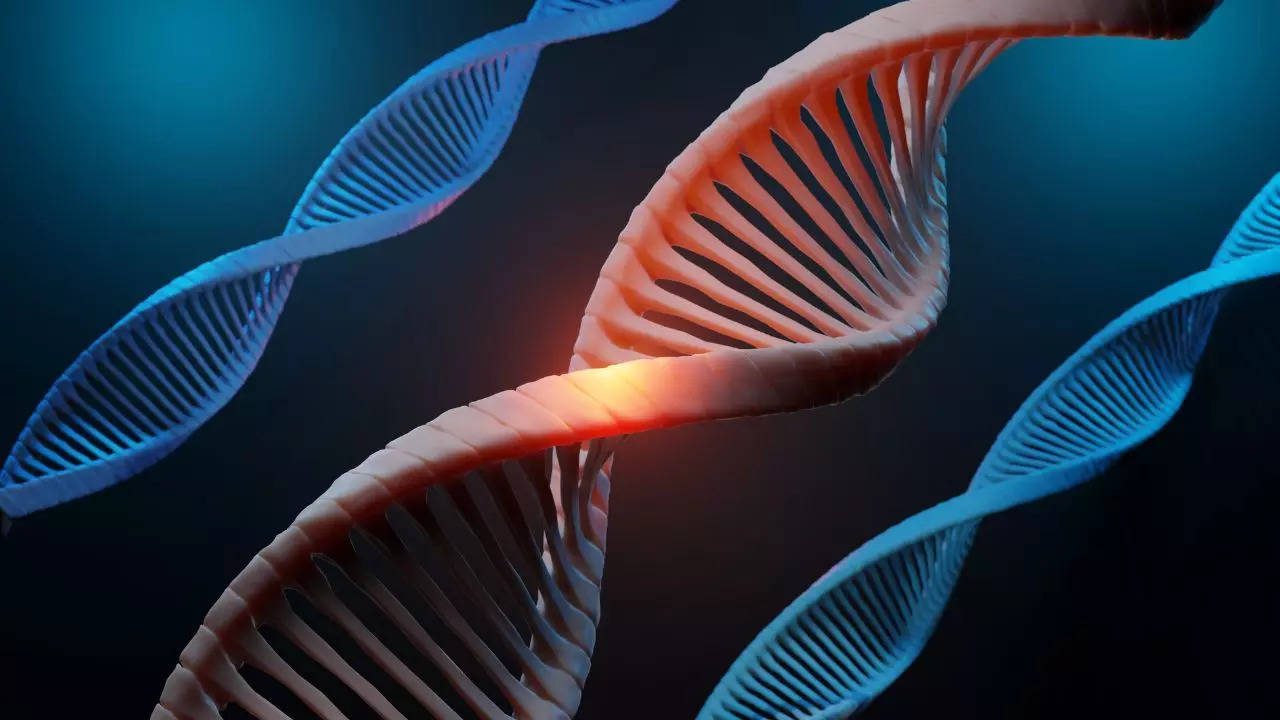Why in news?
- Recently, the ambitious Genome India initiative achieved a significant milestone as researchers completed sequencing 10,000 healthy genomes from different regions of the country, representing 99 distinct populations.
What’s in today’s article?
- Genome sequencing
- Genome India Project
- News Summary
What is genome sequencing?
- Human genome
- The human genome is the entire set of deoxyribonucleic acid (DNA) residing in the nucleus of every cell of each human body.
- It carries the complete genetic information responsible for the development and functioning of the organism.
- The DNA consists of a double-stranded molecule built up by four bases – adenine (A), cytosine (C), guanine (G) and thymine (T).
- Every base on one strand pairs with a complementary base on the other strand (A with T and C with G).
- In all, the genome is made up of approximately 3.05 billion such base pairs.
- Genome sequencing
- While the sequence or order of base pairs is identical in all humans, there are differences in the genome of every human being that makes them unique.
- The process of deciphering the order of base pairs, to decode the genetic fingerprint of a human is called genome sequencing.
- In other words, Genome sequencing is the process of determining the complete DNA sequence of an organism’s genome.
- There are several methods of genome sequencing, but the most common is called next-generation sequencing (NGS).
- NGS allows for rapid, accurate, and cost-effective sequencing of large amounts of DNA.
- Human Genome Project (HGP)
- In 1990, a group of scientists began to work on determining the whole sequence of the human genome under the Human Genome Project.
- The project released the latest version of the complete human genome in 2023, with a 0.3% error margin.
- The process of whole-genome sequencing, made possible by the Human Genome Project, now facilitates the reading of a person’s individual genome to identify differences from the average human genome.
- These differences or mutations can tell us about each human’s susceptibility or future vulnerability to a disease, their reaction or sensitivity to a particular stimulus, and so on.
What are the applications of genome sequencing?
- To evaluate rare disorder
- Genome sequencing has been used to evaluate rare disorders, preconditions for disorders, even cancer from the viewpoint of genetics, rather than as diseases of certain organs.
- Nearly 10,000 diseases — including cystic fibrosis and thalassemia — are known to be the result of a single gene malfunctioning.
- Tool for prenatal screening
- It has also been used as a tool for prenatal screening, to investigate whether the foetus has genetic disorders or anomalies.
- Technology Crispr, which relies on sequencing, may potentially allow scientists to repair disease-causing mutations in human genomes.
- In public health
- Sequencing has been used to read the codes of viruses.
- In January 2020, at the start of the Covid-19 pandemic, Chinese scientist sequenced the genome of a novel pathogen causing infections in the city of Wuhan.
- Later, genome sequencing of the virus led to the development of vaccine and the creation of diagnostic PCR machines.
- India also put in place a sequencing framework. The Indian SARS-COV-2 Genomics Consortia (INSACOG) was tasked with scanning coronavirus samples from patients.
- Uses at the population level
- Advanced analytics and AI could be applied to essential datasets created by collecting genomic profiles across the population.
- This would allow to develop greater understanding of causative factors and potential treatments of diseases.
What is Genome India project?
- The Genome India Project is a gene mapping project sanctioned by the Department of Biotechnology.
- It was launched with the goal of creating a comprehensive database of genetic variations among the Indian population.
- The project aims to sequence the genomes of over 10,000 Indians from different regions of the country and establish a reference genome for the Indian population.
What is the significance of the Genome India project?
- To learn about genetic variants unique to the Indian population
- This project allows researchers to learn about genetic variants unique to India’s population groups and use that to customise drugs and therapies.
- E.g., a mutation MYBPC3 that leads to cardiac arrest at a young age is found in 4.5% of the Indian population but is rare globally.
- Or, another mutation called LAMB3 that causes a lethal skin condition is found in nearly 4% of the population near Madurai but it is not seen in global databases.
- Database for 1.3 billion population
- India’s 1.3 billion-strong population consists of over 4,600 population groups, many of which are endogamous.
- Thus, the Indian population harbours distinct variations, with disease-causing mutations often amplified within some of these groups.
- Findings from population-based or disease-based human genetics research from other populations of the world cannot be extrapolated to Indians.
News Summary: 10,000 human genomes sequenced in India
- The Department of Biotechnology announced the completion of the ‘10,000 genome’ project — an attempt to create a reference database of whole-genome sequences out of India.
- This accomplishment has culminated in the creation of a comprehensive genetic map of India, which holds immense potential for clinicians and researchers alike.
- India is the largest genetic lab in the world. This data can help drive the biology sector in the country as well.
- India’s bio-economy has grown 13 folds in the last 10 years from $10 billion in 2014 to over $130 billion in 2024. It will spearhead India’s future growth.
- The entire dataset will be stored at the Indian Biological Data Centre (IBDC) and will be made available as a digital public good or research.
- Inaugurated in 2022, the IBDC is the country’s only databank.
- Prior to that Indian researchers had to host their biological datasets on American or European servers.
PM Modi announces 4 astronauts for Gaganyaan
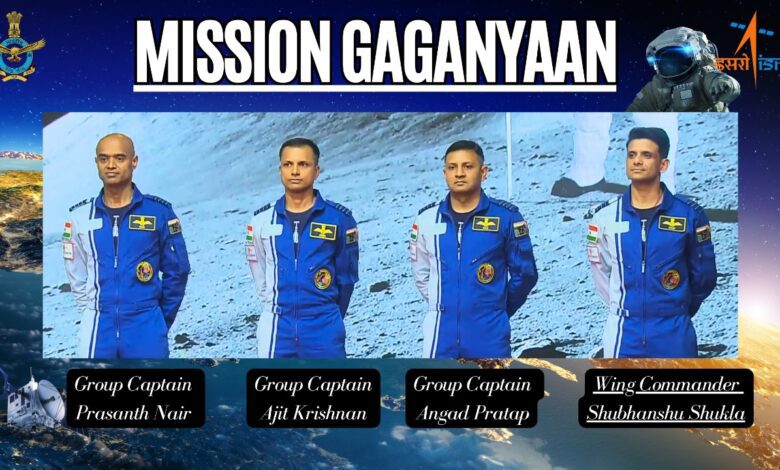
Why in news?
- PM Modi has announced the names of the four astronauts, who would fly to low-Earth orbit as part of ISRO’s Gaganyaan.
- The announcement came just days after ISRO said it had successfully tested the human readiness of the cryogenic engine.
- This engine will be used on the LVM3 vehicles for all of the Gaganyaan missions.
What’s in today’s article?
Gaganyaan
- Gaganyaan project envisages demonstration of human spaceflight capability by launching a crew of 3 members to an orbit of 400 km for a 3 days mission and bring them back safely to earth.
- It is part of the Indian Human Spaceflight Programme (IHSP), which was initiated (2007) by the ISRO to develop the technology needed to launch crewed orbital spacecraft into low earth orbit (LEO).
- Launch Vehicle Mark-3 (LVM3/GSLV Mk3) rocket – the well proven and reliable heavy lift launcher of ISRO, is identified as the launch vehicle for Gaganyaan mission.
- India’s heaviest rocket consists of solid stage, liquid stage and cryogenic stage.
- All systems in the LVM3 launch vehicle are re-configured to meet human rating requirements and christened Human Rated LVM3/HLVM3.
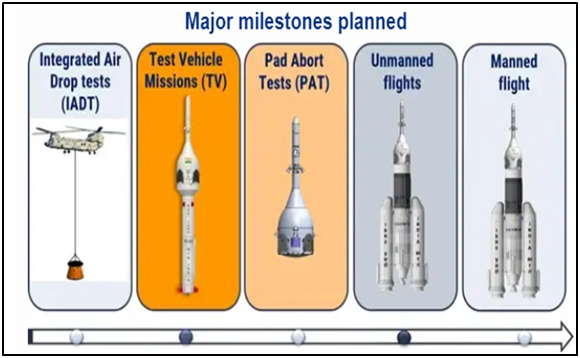
News Summary: PM Modi announces 4 astronauts for Gaganyaan
- PM Modi announced the names of the four astronauts, who would fly to low-Earth orbit as part of the ISRO’s Gaganyaan — the first crewed Indian space mission.
- The selected astronauts are:
- Prashanth Balakrishnan Nair, Angad Prathap, Ajit Krishnan, and Shubanshu Shukla.
- They are all either wing commanders or group captains with the Indian Air Force (IAF) and have extensive experience working as test pilots.
Current status of Gaganyaan missions
- The Gaganyaan missions include both manned and unmanned missions.
- The first unmanned Gaganyaan-1 mission, a test flight to check the technology readiness for the final mission, is scheduled to take off by the end of 2024.
- The manned mission, which will fly a three-membered crew into a low earth orbit at an altitude of 400 km for a period of three days, is scheduled later.
- Human rating of the launch vehicle
- ISRO will use its LVM3 rocket for all of the Gaganyaan missions.
- LVM3, earlier called GSLV-MkIII, is the space agency’s most powerful launch vehicle and has flown seven times and never failed.
- For the manned Gaganyaan mission, ISRO has reconfigured all the components of LVM3 to meet human rating requirements.
- Recently, in February 2024, the space agency performed final tests on the rocket’s cryogenic engine, known as CE20, which will power LVM3 during the cryogenic stage of the lift-off.
- The engine successfully passed and was certified for missions that would transport humans into space.
- The ‘Vikas’ engine to be used in the liquid stage and the solid booster, a part of the solid stage, have already qualified for the missions.
- Development of crew module and crew escape system
- ISRO is also developing technology for the proposed human-space flight mission.
- These include:
- the development of life support systems to provide an earth-like environment to the crew in space,
- crew emergency escape provision, and
- evolving crew management aspects for training, recovery, and rehabilitation of crew.
- In October 2023, the space agency successfully conducted the first test of a basic crew module and crew escape system (CES).
- CES is a part of the module that ensures “the crew is taken to a safe distance in case of any emergency either at launch pad or during ascent phase.
- The next month, the space agency began to experiment with a crew module uprighting system.
- This system is used to ensure that the crew module, making a splashdown in the sea after a space mission, stays upright and does not get inverted in the water.
- Training of astronauts
- The four selected astronauts have completed their generic training at Russia’s Yuri Gagarin Cosmonaut Training Centre.
- Their training took place after ISRO-Glavkosmos (a subsidiary of Russian space agency Roscosmos) signed an MOU in June 2019.
- The astronauts are currently undergoing training at ISRO’s astronaut training facility in Bengaluru.
- One of the four astronauts is also expected to be trained by the American space agency NASA.
Why Sustainable Funding matters for India’s ‘Science Power’ Ambition
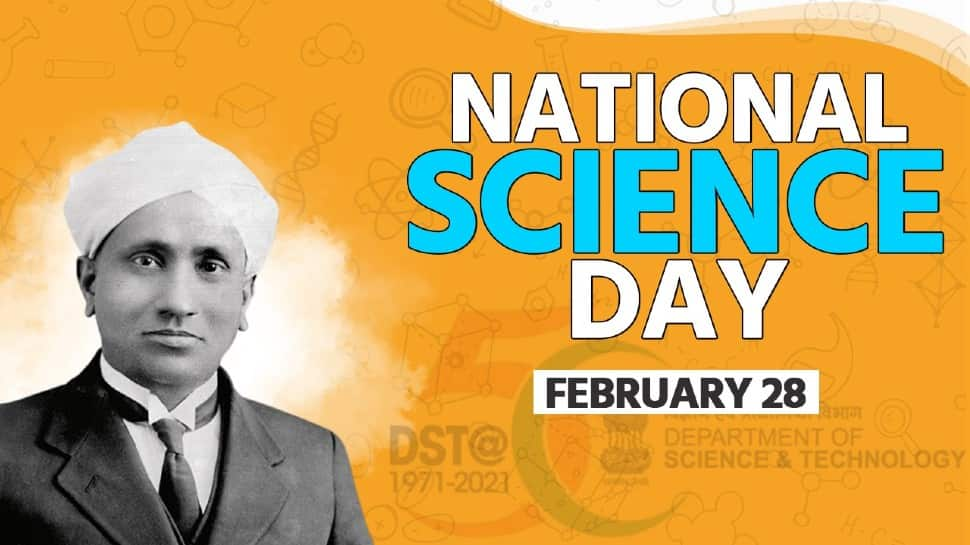
What’s in Today’s Article?
- Background (Context of the Article)
- India’s R&D Spending (Statistics, Ways to Improve, Role of Pvt Sector, Sustainable Funding)
Background:
- The 2024 theme for National Science Day, which India celebrates every year on February 28, is “Science for Sustainable Development”.
- Science and technological developments are key drivers of India’s journey towards becoming a developed country by 2047.
- India is committed to making this progress through sustainable means, as evidenced by its commitments under the Paris Agreement.
- The role of science in driving sustainable development doesn’t need emphasis.
- However, any conversation on science is incomplete without setting one key expectation: for science to transform India, it has to be sustainably and consistently funded.
How Much is India Spending on R&D?
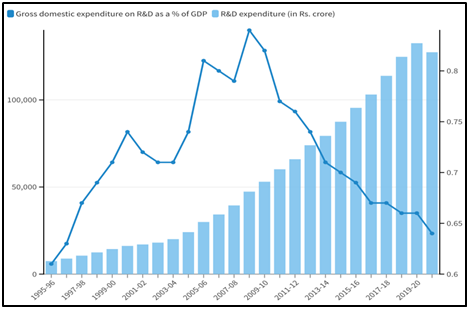
- Funding for fundamental research in India is amongst the world’s lowest, particularly for a country with high science and technology ambitions.
- In the recent past, India’s R&D expense has dropped to the current 0.64% of GDP from 0.8% in 2008-2009 and 0.7% in 2017-2018.
- This reduced expenditure is worrying considering government agencies themselves have issued several calls to double this spending.
- The 2013 Science, Technology, and Innovation Policy noted that “Increasing Gross Expenditure on R&D (GERD) to 2% GDP has been a national goal for some time”.
- The 2017-2018 Economic Survey reiterated this in its chapter on science and technology transformation.
- The reasons for the reduction in R&D spending despite the government being cognisant of the need to increase it are not clear.
- However, it may stem from a lack of coordination between government agencies and a need for stronger political will to prioritise R&D expenses.
- Most developed countries spend between 2% and 4% of their respective GDPs on R&D.
- In 2021, member-countries of the Organisation for Economic Co-operation and Development (OECD) on average spent 2.7% of GDP on R&D.
- The U.S. and the U.K. have consistently spent more than 2% of their GDPs on R&D for the past decade.
- So, many experts have called for India to spend at least 1%, but ideally 3%, of its GDP every year until 2047 on R&D for science to have a meaningful impact on development.
How Can India Improve its R&D Spending?
- For India to reach ‘developed nation’ status, it needs to spend more to scale R&D than developed countries spend to maintain that status.
- This is the foundation of the demand to spend at least 3% of the GDP on R&D annually until 2047.
- And beyond the current spending being inadequate, its primary dependence on public money signals an immature financing system and weak domestic market.
- In 2020-2021, private sector industry contributed 36.4% of the GERD whereas the Union government’s share was 43.7%.
- State governments (6.7%), higher education (8.8%), and public sector industry (4.4%) were the other major contributors.
Hesitance of the Private Sector:
- In economically developed countries, a major share – 70% on average – of R&D investment comes from the private sector.
- The hesitancy of private-sector funding may be because of:
- poor capacity to evaluate R&D in India,
- ambiguous regulatory roadmaps that can deter investors,
- lack of clear exit options for investors in sectors such as biotechnology, and
- fears of intellectual property rights theft.
How is the R&D Budget Utilised?
- While the need for India to at least double its R&D investment has been expressed several times, the question of how effectively the allocated money is spent is explored less often.
- The Union Ministry of Science and Technology has consistently under-utilised its budget.
- In 2022-2023, the Department of Biotechnology (DBT), used only 72% of its estimated budget allocation on Centrally Sponsored Schemes/Projects.
- The Department of Science and Technology (DST) used only 61%.
- The Department of Scientific and Industrial Research (DSIR), which receives the lowest allocation for Centrally Sponsored Schemes, spent 69% of its allocation.
Sustainable Funding for R&D is the Way Forward:
- In the latest budget, Finance Minister Nirmala Sitharaman provided many indications that the government would like R&D expenditure to include more contributions from the private sector.
- Against this backdrop, mitigating the under-spending and under-utilisation of funds earmarked for R&D stand out as obvious first steps.
- This in turn requires the political prioritisation of R&D spending and recognition of it as a core, irreplaceable element of India’s growth journey.
- This prioritisation has to happen not only within the concerned Ministries but also at the Ministry of Finance, which disburses the funds.
- Incentives for private investment, including relaxation of foreign direct investments, tax rebates, and clear regulatory roadmaps for products will help build investor confidence.
- Finally, India also needs the bureaucratic capacity to evaluate science projects and, after allocations, monitor utilisation.
- Building such capacity is a prerequisite for India becoming a science power by 2047.
